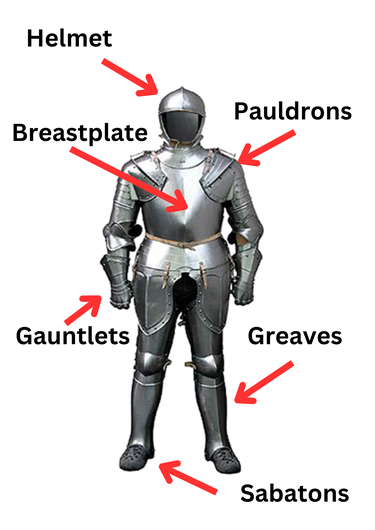Armed to the teeth: A guide to the weapons and armour of a medieval knight

In the Middle Ages, knights were revered for their strength, bravery, and skill in battle. A critical component of their success on the battlefield was their weapons and armour.
The armour and weaponry used by medieval knights were an extension of themselves, providing protection, power, and status.
In this article, we will explore the weapons and armour of a medieval knight, examining their history, evolution, and significance in battle.
Swords
Swords were an essential weapon used by medieval knights, and they played a significant role in combat.
The sword was versatile, capable of delivering quick, deadly blows, and was often used in conjunction with a shield or another melee weapon like a mace or an axe.
The use of swords by knights was dependent on a variety of factors, including the type of sword, the opponent, and the battlefield conditions.
Knights were trained to use swords in a variety of ways, including thrusting, cutting, and parrying.
The sword was often used in combination with a shield, which allowed the knight to block incoming blows and create openings for their own attacks.
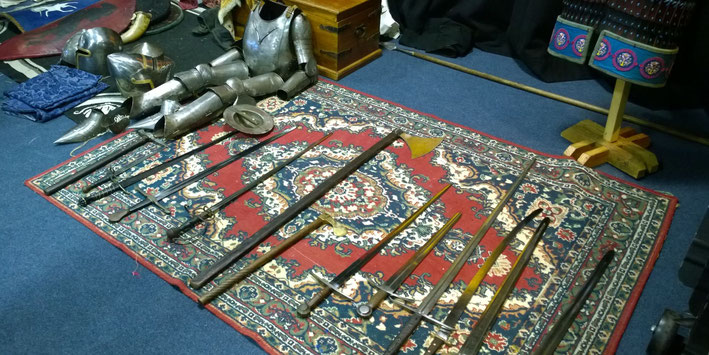
There were various kinds of swords used by knights, each with its unique features and characteristics. Some of the most common types of swords used by medieval knights included:
Longsword:
The longsword was the most iconic sword used by knights. It was a two-handed sword with a straight, double-edged blade that was both heavy and versatile. The longsword was used for both thrusting and cutting, making it a deadly weapon in the hands of a skilled knight.
Arming Sword:
The arming sword was a one-handed sword with a straight blade that was shorter and lighter than the longsword. The arming sword was versatile, and knights often used it in conjunction with a shield for added protection.
Greatsword:
The greatsword was a massive two-handed sword that was primarily used by foot soldiers rather than knights. The greatsword was often used to break through enemy lines or to deliver devastating blows to enemy formations.
Falchion:
The falchion was a single-edged sword with a curved blade that was designed for cutting rather than thrusting. The falchion was often used in close combat and was particularly effective against unarmored opponents.
Lance
A lance was a long pole weapon with a sharp metal tip used by knights in medieval warfare.
It was a primary weapon for knights when mounted on a horse and was used in charging attacks against enemy cavalry or infantry.
The lance allowed the knight to strike from a greater distance, making it a formidable weapon on the battlefield.
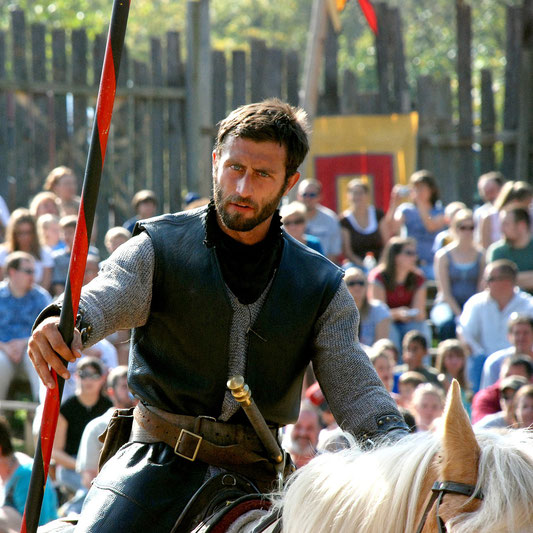
When used by knights, the lance was held with one hand, with the butt end resting against the knight's stirrup.
The knight would then charge towards the enemy at full speed, with the lance pointed at the enemy's chest.
The sharp tip of the lance would penetrate through the enemy's armor or shield, causing serious injury or death.
Lances were also used in jousting tournaments, a popular pastime among knights. In jousting, two knights would ride towards each other on horseback, each wielding a lance.
The objective was to strike the opponent with the tip of the lance, while at the same time avoiding being struck.

Armour
In medieval times, armor was a crucial component of a knight's equipment. It protected the knight from enemy weapons and provided a means to assert dominance and status.
There were various types of armor that knights could wear, each with their unique features and characteristics.
Some of the most common types of armor include:
Chain Mail:
Chain mail was made of interlocking metal rings and was a popular armor choice for knights. It was relatively lightweight, flexible, and provided excellent protection against cutting and stabbing weapons. Chain mail was commonly worn over a padded tunic or shirt to absorb the impact of blows.
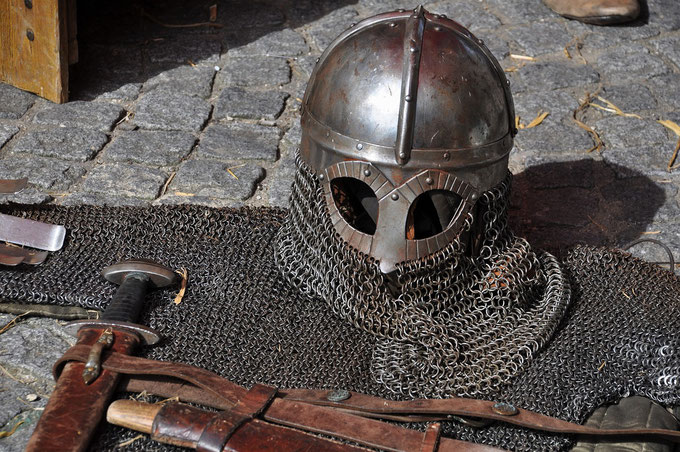
Plate Armor:
Plate armor was made of solid metal plates and was the most protective type of armor available to knights. It covered the entire body and consisted of various parts, such as a helmet, breastplate, gauntlets, and greaves. Plate armor was heavy and cumbersome, making it more challenging to move in but provided excellent protection against enemy weapons.
Leather Armor:
Leather armor was made of boiled or hardened leather and was a popular choice for light cavalry or infantry. It was relatively lightweight and flexible, providing good protection against cutting weapons but was less effective against piercing weapons.
Scale Armor:
Scale armor was made of small, overlapping metal or leather scales and was a popular armor choice for knights in the early medieval period. It was lightweight and flexible, providing good protection against cutting weapons.
Brigandine:
Brigandine armor was made of overlapping metal plates, sandwiched between layers of cloth or leather. It was lighter than full plate armor but provided better protection than chain mail. Brigandine armor was a popular choice for knights in the 14th and 15th centuries.
Parts of plate armour
A suit of plate armor was the pinnacle of medieval armor technology, providing the highest level of protection for knights in battle.
A complete suit of plate armor was composed of many different components, each designed to protect a specific part of the body while allowing the knight to move and fight effectively.
The main components of a suit of plate armor include:
Helmet:
The helmet was the most crucial part of the suit of armor, protecting the head and face. It was usually made of several metal plates joined together and had a visor that could be raised or lowered. The helmet could also have a crest or plume to identify the knight.
Breastplate:
The breastplate was a large metal plate that covered the chest and stomach. It was usually decorated with intricate designs or heraldry and was one of the most critical components of the armor, protecting the vital organs.
Backplate:
The backplate was a metal plate that covered the back and was attached to the breastplate. It protected the spine and was an essential component of the armor.
Pauldrons:
Pauldrons were metal plates that covered the shoulders and upper arms. They were often articulated to allow for movement and provided protection against blows to the upper body.
Gauntlets:
Gauntlets were metal gloves that protected the hands and wrists. They were designed to allow the knight to grip weapons effectively while providing excellent protection for the hands.
Greaves:
Greaves were metal plates that protected the lower legs and were attached to the sabatons. They provided protection against blows to the legs and were often decorated with intricate designs.
Sabatons:
Sabatons were metal shoes that protected the feet and ankles. They were usually made of several metal plates joined together and were designed to allow the knight to move and fight effectively.
Shields
Shields were a critical component of a knight's equipment, providing a means of defense against enemy weapons.
Shields were used to deflect blows from swords, axes, and other weapons and could be used offensively to push back opponents.
There were several types of shields used by knights, each with its unique features and characteristics.
Some of the most common types of shields include:
Heater Shield:
The heater shield was a shield with a distinctive teardrop shape. It was typically made of wood and covered in leather or cloth, and had a metal boss or shield boss in the center. The heater shield was a popular choice for knights in the 14th and 15th centuries.
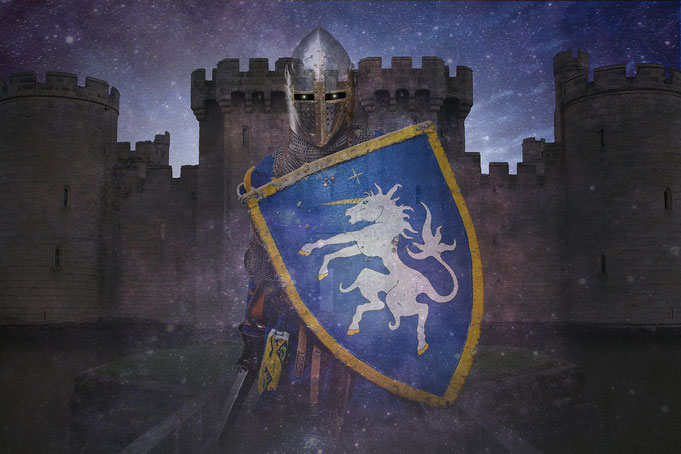
Kite Shield:
The kite shield was a shield with a distinctive triangular shape and a curved top. It was typically made of wood and covered in leather or cloth, and had a metal boss or shield boss in the center. The kite shield was a popular choice for knights in the 12th and 13th centuries.
Buckler:
The buckler was a small, round shield that was held in the hand. It was typically made of wood or metal and was used to deflect blows from swords and other weapons. The buckler was a popular choice for knights in the 16th century.
Targe:
The targe was a small, round shield that was typically made of wood and covered in leather or cloth. It had a metal boss in the center and was often decorated with intricate designs or heraldry. The targe was a popular choice for Scottish knights and warriors.
Other melee weapons
Knights had access to a wide range of weapons beyond swords and lances. These weapons could be used in various combat situations, and each had its unique advantages and disadvantages.
Some of the most common types of weapons used by knights included:
Maces:
A mace was a heavy, blunt weapon that was used to crush armor and injure opponents. It had a metal head and a wooden or metal handle and was typically used in close combat.
Axes:
An axe was a weapon with a metal blade mounted on a wooden or metal handle. It was used to chop or hack at opponents and was especially effective against unarmored opponents.
War Hammers:
A war hammer was a weapon with a heavy metal head mounted on a wooden or metal handle. It was designed to crush armor and was often used in combination with a mace or an axe.
When used in combination... the knight was lethal
As you can now see, the weapons and armor used by medieval knights were essential in defining their success on the battlefield.
The swords, lances, spears, armor, and shields were designed to provide the knights with the necessary means of defense and attack in a battle situation.
The choice of weapon was determined by the type of combat and the knight's personal preferences.
Similarly, the armor used by the knights provided crucial protection against the deadly blows of enemy weapons, allowing them to survive and emerge victorious.
Overall, the combination of skill, strategy, and the right equipment made medieval knights some of the most fearsome warriors in history, inspiring awe and admiration to this day.
What do you need help with?
Download ready-to-use digital learning resources
Copyright © History Skills 2014-2024.
Contact via email
With the exception of links to external sites, some historical sources and extracts from specific publications, all content on this website is copyrighted by History Skills. This content may not be copied, republished or redistributed without written permission from the website creator. Please use the Contact page to obtain relevant permission.

